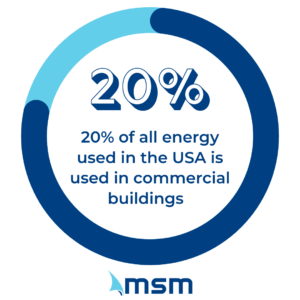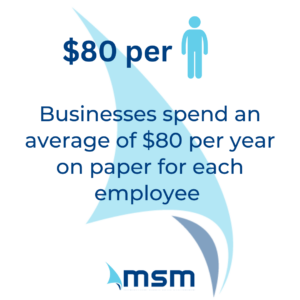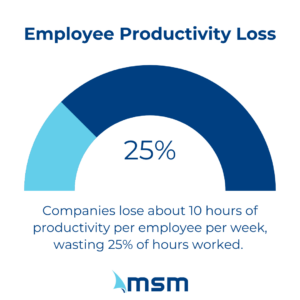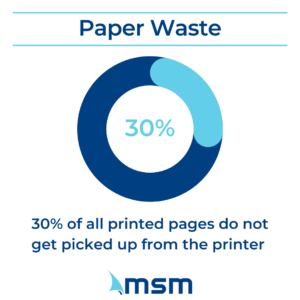When it comes to running a business, cutting costs to maximize profits is always a top priority. However, one area that is often overlooked is the back office, where inefficiencies can lead to a significant waste of time and money. In this article, we will discuss the top five biggest back-office money wasters and how they can be addressed to help businesses save money.
Energy Costs
Energy Cost waste is another significant factor that contributes to back-office money wasters. Most offices operate with a substantial amount of electronic equipment that needs energy to function. As a result, the energy cost used in offices is generally high and can significantly impact the company’s bottom line. In addition, companies may be using more energy than they need to, leading to wasted energy and unnecessary costs.
 According to the U.S. Department of Energy, commercial buildings consume approximately 20% of all the energy used in the United States. This energy consumption contributes significantly to greenhouse gas emissions, which have a detrimental effect on the environment. Therefore, the Department of Energy suggests that reducing energy consumption in commercial buildings could help to reduce greenhouse gas emissions, save money, and improve energy security.
According to the U.S. Department of Energy, commercial buildings consume approximately 20% of all the energy used in the United States. This energy consumption contributes significantly to greenhouse gas emissions, which have a detrimental effect on the environment. Therefore, the Department of Energy suggests that reducing energy consumption in commercial buildings could help to reduce greenhouse gas emissions, save money, and improve energy security.
There are several ways that companies can reduce energy consumption and save on energy costs. One way is to upgrade to energy-efficient equipment, such as LED lighting and Energy Star-rated appliances. Companies can also reduce energy usage by encouraging employees to turn off lights and electronics when not in use, and by implementing energy-saving practices, such as using natural light instead of artificial light.
In addition, companies can conduct energy audits to identify areas where energy is being wasted and implement energy-saving measures accordingly. Such measures can include improving insulation and sealing, upgrading HVAC systems, and optimizing energy usage during peak demand hours.
Overall, reducing energy waste in the back office can significantly impact a company’s bottom line and the environment. As a result, companies can reduce costs and contribute to a more sustainable future by implementing energy-saving measures.
Paper Usage
Paper usage is one of the most significant sources of waste in the back office. Despite efforts to go paperless, many businesses still rely heavily on paper for record-keeping, note-taking, and printing. This has resulted in a significant amount of paper waste, which can hurt both the environment and the bottom line.
According to the Environmental Protection Agency (EPA) report, paper and paperboard products account for the largest percentage of municipal solid waste in the United States, with an estimated 67 million tons generated in 2018. Additionally, the report estimates that 26 percent of that paper waste comes from offices and other commercial and institutional sources.
Paper waste costs go beyond just the cost of the paper itself. There are also costs associated with printing, copying, and storing paper documents. For example, the average office worker uses about 10,000 sheets of paper per year, which equates to about $80 per employee per year in printing costs alone.
Paper waste also has environmental impacts, contributing to deforestation and greenhouse gas emissions. According to the EPA, the energy used to produce and dispose of paper accounts for about 4 percent of total greenhouse gas emissions in the U.S.
To reduce paper waste in the back office, businesses can implement various strategies, including digitizing documents, printing double-sided, and using email instead of paper-based communication. Additionally, recycling programs can be implemented to ensure that any paper waste generated is properly disposed of and reused where possible.
By taking steps to reduce paper waste in the back office, businesses can save money, reduce their environmental impact, and improve overall efficiency.
Employee Productivity
Employee productivity is a critical factor that can directly impact a company’s bottom line. However, studies show employee productivity waste is prevalent in many back office settings. According to a study by Workfront, the average worker wastes about 2 hours and 9 minutes per day on non-work-related activities. This means that, on average, companies lose about 10 hours of productivity per employee per week.
One major culprit for employee productivity waste is distractions. The same Workfront study found that the top distraction for employees is emails, followed by meetings and coworkers dropping by. Furthermore, a study by Udemy uncovered that 34% of employees consider social media to be their biggest distraction at work.
Another factor that can lead to employee productivity waste is a lack of clarity and direction. When employees are unsure of their priorities and goals, they may spend time on tasks that are not essential or not aligned with the company’s objectives. According to a study by AtTask, 40% of employees say they do not know their priorities.
Moreover, another study by the University of California, Irvine, found that it can take up to 23 minutes for an employee to get back on track after being distracted. This loss of time can add up quickly and have a significant impact on productivity.
Companies can implement various strategies to combat employee productivity waste, including providing clear guidance and direction to employees, minimizing distractions, and encouraging regular breaks to improve focus and creativity. Additionally, offering training on time management and task prioritization can help employees better manage their workload and increase productivity.
Printer Ink and Toner
In the modern office environment, printing is still a necessary and essential part of daily operations. While digital documents and communication have become more prevalent, the demand for printing and paper remains high. However, printing can be a significant source of waste, and printer ink and toner contribute to the problem.
Printer ink and toner waste is often a significant issue for businesses, though many do not realize it. Several factors go into the problem of ink and toner waste.
One area in that businesses lose money related to printer ink and toner is through purchasing low-quality toner from online retailers, like Amazon. With the cost of the average ink cartridge being up 9%, companies are looking for ways to save. This often leads to purchasing managers searching the internet for the cheapest ink they can find. But, often, the cheap ink will cost businesses much more money in the long term.
Another printer ink and toner waste issue in back offices is that over 90% of businesses do not track their printer use or expenses. By not tracking print usage, most businesses print more than is necessary, with up to 30% of printed pages not even being picked up by anyone. And, by not tracking print usage, businesses often run low or completely out of ink and waste money by then refilling their supply by whatever vendor can get the ink and toner to them the fastest.
To reduce printer ink and toner waste in the office, businesses can consider implementing measures such as setting up printing policies, monitoring and tracking printing usage, and recycling empty cartridges. Additionally, companies can utilize a managed print services (MPS) software or a third-party provider. By doing so, companies can reduce their environmental impact and save money on unnecessary waste.
Office Supplies
Office supply waste is a major problem in many back offices, resulting in significant business financial losses. This waste can come in the form of unused or unnecessary supplies, such as pens, paper, and staples, as well as excess packaging from deliveries.
The overuse and misuse of office supplies also contribute to the problem. Many employees often order more supplies than they actually need, resulting in excess inventory and wasted resources. Furthermore, employees may leave office equipment running when not used, leading to wasted energy and higher utility bills.
Another source of office supply waste is the excessive packaging used in shipping and delivery. This includes using plastic bags, bubble wrap, and cardboard boxes, which can accumulate in back offices and contribute to landfill waste.
Overall, the amount of waste generated by office supplies in the back office is substantial and significantly impacts the environment and business finances. To combat this problem, businesses can implement policies and practices that promote responsible supply use and waste reduction, such as encouraging double-sided printing and recycling programs.
Conclusion
Businesses need to identify and address inefficiencies and waste in the back office to maximize profits. This article discusses five of the biggest money wasters in the back office, including energy costs, paper usage, employee productivity, printer toner, and office supplies. By implementing small changes in each of these areas, even without increasing revenue, businesses can experience substantial growth in profits.







